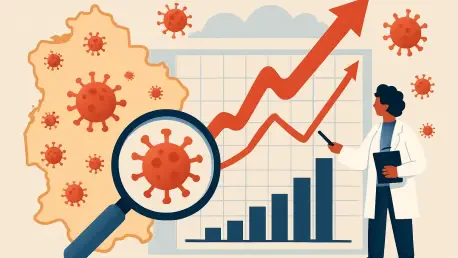Epidemic forecasting has long been a cornerstone of public health, yet the ability to predict critical moments like outbreak peaks or hospital demand surges has remained elusive for many traditional models. A groundbreaking approach known as epimodulation, developed by researchers at the University of Texas at Austin, is changing the game by offering a remarkable 55% improvement in forecast accuracy during peak times. This method promises to transform how healthcare systems prepare for and respond to infectious disease outbreaks, addressing a pressing need for reliable data to guide resource allocation and intervention strategies.
The significance of this advancement cannot be overstated, as accurate predictions of epidemic dynamics directly impact the ability of hospitals and community leaders to manage crises effectively. Epimodulation integrates core epidemiological principles into forecasting models, moving beyond mere data trends to provide biologically informed insights. This innovative technique stands to redefine outbreak response by equipping decision-makers with tools to anticipate critical turning points with unprecedented precision.
This guide aims to explore the intricacies of epimodulation, detailing how it overcomes long-standing challenges in epidemic forecasting. Readers will gain a comprehensive understanding of the method’s mechanisms and its potential to enhance public health preparedness. By delving into actionable steps and real-world implications, the following sections will illuminate why this approach marks a pivotal shift in managing infectious disease threats.
The Persistent Challenge of Epidemic Forecasting
Predicting the trajectory of an epidemic has historically been fraught with difficulties, largely due to the limitations of traditional forecasting methods. Models that rely heavily on machine learning or simple trend extrapolation often fail to capture the nuanced turning points of an outbreak, such as when case numbers peak or begin to decline. These approaches typically project current data forward without considering the complex interplay of biological and behavioral factors that influence disease spread.
Such shortcomings can have dire consequences for healthcare planning, as inaccurate forecasts may lead to underprepared hospitals or misallocated resources during critical periods. For instance, failing to anticipate a surge in hospitalizations can strain medical facilities, while overestimating demand can divert essential supplies unnecessarily. The unpredictability of epidemic curves has long underscored the need for more sophisticated tools that account for underlying dynamics beyond raw numbers.
Epimodulation emerges as a solution to these persistent issues, offering a way to bridge the gap between data-driven predictions and real-world outbreak behavior. By addressing the root causes of forecasting errors, this method provides a lifeline for public health officials seeking reliable insights. The urgency for such innovation is evident, as past failures in prediction have often jeopardized effective response strategies, highlighting the critical role of advanced methodologies in safeguarding communities.
How Epimodulation Transforms Forecasting Accuracy
Epimodulation represents a paradigm shift in epidemic forecasting by embedding scientific understanding into predictive models. This section breaks down the approach into actionable steps, providing a clear roadmap for grasping its transformative potential. Each component builds on the last, offering a structured guide to understanding how this method achieves superior accuracy.
Step 1: Embedding Epidemiological Principles
At the heart of epimodulation lies the integration of fundamental epidemiological concepts into forecasting frameworks. Unlike traditional models that follow data trends without context, this approach accounts for natural factors like rising population immunity or shifts in public behavior that slow disease transmission. By programming models to expect these dynamics, epimodulation ensures predictions align more closely with biological realities.
Understanding Curve Dynamics
Epidemic curves do not follow a straight path; they naturally bend as factors like immunity or interventions take effect, reducing infection rates over time. Epimodulation equips models to anticipate these slowdowns rather than assuming constant growth, leading to more realistic outcomes. This step is crucial for avoiding the overestimations or underestimations that plague conventional systems, providing a foundation for reliable forecasting during critical phases.
Step 2: Detecting Early Signals of Change
Another key strength of epimodulation is its ability to identify subtle indicators of shifts in infection rates before they become apparent in broader data trends. By focusing on early warning signs, such as declining transmission in specific regions or demographics, the method allows for timely adjustments to forecasts. This responsiveness ensures that predictions remain relevant even as outbreak conditions evolve rapidly.
Leveraging Real-Time Data Insights
The use of real-time data is pivotal in refining epimodulation’s accuracy during dynamic outbreak phases. By continuously updating models with incoming information, the approach adapts to changes on the ground, such as new public health measures or unexpected spikes in cases. This adaptability minimizes errors and enhances the utility of forecasts for immediate decision-making in healthcare settings.
Step 3: Improving Peak-Time Predictions
Epimodulation has demonstrated a striking 55% improvement in forecasting hospital admissions during epidemic peaks, a metric of paramount importance for resource planning. Accurate predictions at these high-stress moments enable hospitals to prepare for surges in demand, ensuring that staffing and supplies are aligned with actual needs. This precision marks a significant leap forward in managing outbreak crises.
Enhancing Healthcare Preparedness
The practical benefits of precise peak-time forecasts are immense, translating directly into actionable strategies for healthcare providers and community leaders. With reliable data, hospitals can scale up intensive care capacity or secure additional ventilators in advance, while local authorities can time interventions like lockdowns more effectively. This step underscores epimodulation’s role in mitigating the chaos often associated with epidemic surges.
Step 4: Broadening Applicability Across Diseases
Versatility is a hallmark of epimodulation, as the method has been successfully tested on historical data from influenza and COVID-19 outbreaks. Its design allows for adaptation to a wide range of infectious diseases that exhibit wave-like patterns, making it a valuable tool for diverse public health challenges. This broad applicability ensures that the approach remains relevant across varying contexts.
Adapting to Emerging Pathogens
Looking ahead, epimodulation shows promise for addressing future threats posed by emerging pathogens like bird flu or Ebola. Its framework can be tailored to new diseases by adjusting parameters based on specific transmission characteristics, preparing systems for unknown challenges. This forward-thinking adaptability positions the method as a cornerstone for long-term epidemic preparedness.
Key Takeaways from Epimodulation’s Impact
The advantages of epimodulation are clear and substantial, offering a robust solution to long-standing forecasting challenges. Below is a concise summary of its primary benefits for quick reference:
- Delivers a 55% improvement in hospital admission forecasts during epidemic peaks.
- Incorporates epidemiological principles for predictions grounded in biological realities.
- Supports real-time decision-making for effective healthcare resource allocation.
- Proves versatile across multiple infectious diseases and historical outbreak data.
- Enhances existing ensemble forecasting models without necessitating major system changes.
These points encapsulate the method’s potential to revolutionize how outbreaks are managed. By addressing critical gaps in accuracy, epimodulation provides a reliable framework for navigating the uncertainties of infectious disease spread. Public health systems stand to gain significantly from adopting this approach as a standard tool in their arsenal.
Future Implications for Public Health and Beyond
Epimodulation fits seamlessly into a broader movement within public health toward hybrid forecasting models that blend data science with domain-specific expertise. This shift reflects a growing consensus among experts that combining statistical analysis with scientific theory yields more dependable results, particularly during unpredictable outbreak phases. As this trend gains traction, epimodulation serves as a model for integrating interdisciplinary knowledge into practical tools.
Scaling this method to address novel pathogens or global outbreaks presents both opportunities and challenges that warrant further exploration. While the approach has shown success with known diseases, adapting it to entirely new threats may require additional research into unique transmission patterns. Future developments could focus on embedding epimodulation into national and international forecasting systems to standardize its application on a larger scale.
The potential impact of this innovation extends to shaping global outbreak response strategies in an era of heightened connectivity. By improving the reliability of predictions, epimodulation can help societies prepare for emerging infectious threats with greater confidence. As public health continues to evolve, this method offers a blueprint for building resilience against the uncertainties of future epidemics, ensuring that communities are better equipped to respond.
Embracing Epimodulation for a Safer Tomorrow
Reflecting on the journey of epimodulation, it becomes evident that this approach marks a turning point in epidemic forecasting with its remarkable 55% accuracy boost during peak periods. The steps taken to integrate epidemiological insights into predictive models have paved the way for more reliable and actionable data, empowering healthcare systems to tackle outbreaks with precision. Each component of the method, from detecting early signals to enhancing peak-time forecasts, contributes to a stronger framework for managing public health crises.
Looking ahead, the next steps involve a concerted effort by public health officials, researchers, and policymakers to adopt and refine this innovative tool. Collaboration across sectors could drive further advancements, such as tailoring epimodulation for real-time integration into emergency response protocols. Exploring partnerships with technology developers to create user-friendly platforms for its implementation also emerges as a vital consideration for widespread impact.
Ultimately, the legacy of epimodulation rests in its capacity to inspire a proactive stance against infectious disease threats. By continuing to invest in research and application of such methodologies, societies can build a more robust defense against future outbreaks. This focus on innovation and adaptability promises to strengthen global health security, ensuring that communities stand ready to face whatever challenges lie on the horizon.









